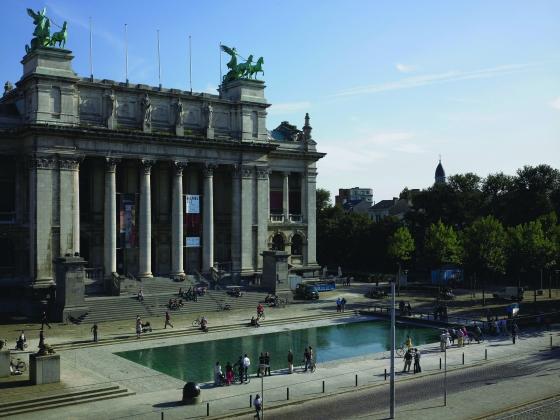Royal Museum of Fine Arts

Royal Museum of Fine Arts Antwerp
Lange Kievitstraat 111-113 bus 100
2018 Antwerp
Belgium
P 0032 (0)3 224 95 50
A variety of Belgian artists with abstract work are represented in the collection of the Royal Museum of Fine Arts in Antwerp (KMSKA). On the one hand, it deals with the artists who choose for the abstract as a means of expression in the 1920’s between the two World Wars. On the other hand, it concerns artist that only did so after 1945. The KMSKA only acquired work some decades removed from the date of origin of the abstract movements in Belgium.
After the First World War, the guiding principles of the Pure Plasticism find an entrance into Antwerp in 1918 and in Brussels in 1922. It was a regional form of Constructivism, a tendency that gained a form in the post-war years in Europe between the two World Wars. With the painter Jozef Peeters, advocate and theoretician of Pure Plasticism and the Modern Art circle, Antwerp was a lively and important centre for the development and promotion of these artistic trends. Nonetheless, only just in the 1960’s and later did the KMSKA acquire abstract compositions by Jozef Peeters, Victor Servranckx, Edmond Van Dooren, Jos Léonard and Jan Kiemeneij, who partially or wholly, respond to the principles of Pure Plasticism.
The reason for the non-acquisition of pieces during the uprising and growth of Pure Plasticism was probably twofold. The museum only acquired modern art that was exhibited at the Triennial exhibitions of Antwerp and selected by a specially organised committee for this purpose. From this principle, the museum did not deviate from post-World War Two. As such, Pure Plasticism did not gain access to the official institutions. As a consequence, the exhibition, in the context of the Second Congress for Modern Art in Antwerp, and organised by the eponymous Antwerp Circle, through the collective protest of the professors of the Academy of Antwerp, does not take place in the main hall of the museum. When the writer, exhibitions’ creator and journalist Jozef Muls (1882 - 1961), who was Chairman in 1920 of the First Congress for Modern Art, becomes appointed Adjunct-Conservator of the museum in 1926, Pure Plasticism has already passed its zenith. As the editor of the publication Vlaamsche Arbeid, Muls primarily admits the texts of lectures on modern literature.
After the Second World War, the stance of the museum world towards contemporary art changes. Various European museums, such as the Stedelijk Museum in Amsterdam and the Van Abbemuseum in Eindhoven, chose for the display and following of modern art that per definition is continuously in flux. In 1959, Head Conservator Walther Vanbeselaere strives for a similar policy. He formulates his mission statements at the moment that Antwerp is an internationally appreciated centre for the avant-garde. In the vision of a full-fledged activity around modern art, beginning from the 1960’s, the KMSKA exhibits and purchases work by Belgian artists, who with their research, experiments and plastic forms of expression fit in amongst the various, new tendencies in European art after 1945.
A diversity of the tendencies result in new forms of abstraction such as informal art, monochromatic and achromatic, action painting, lyrical abstract, constructivism, kinetic art, and assemblage. The majority of acquisitions primarily occur on the occasion of the following exhibitions: 1947/1967 Kontrasten: schilderkunst in België/ Contrasts: painting in Belgium (1968), G-58 Hessenhuis (1973), Zero internationaal Antwerpen (1979-1980) and Informele kunst in België en Nederland, 1955-1960: parallel in de Nederlandstalige literatuur/ Informal art in Belgium and the Netherlands, 1955-1960: parallel to Dutch-language literature (1984).
Greta Van Broeckhoven
CC BY (Creative Commons 4.0)